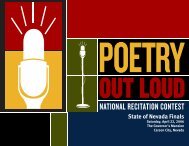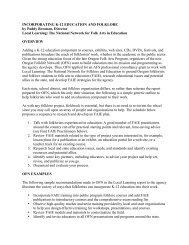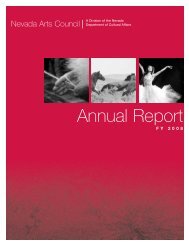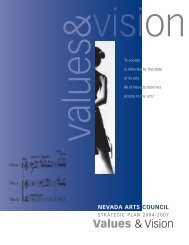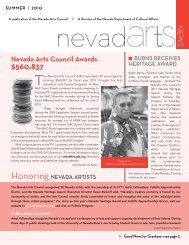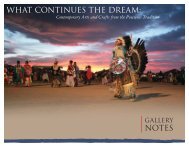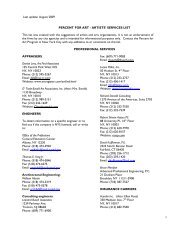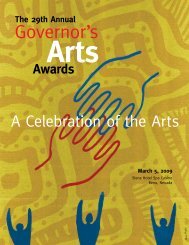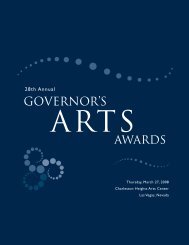Education Guide - Nevada Arts Council
Education Guide - Nevada Arts Council
Education Guide - Nevada Arts Council
Create successful ePaper yourself
Turn your PDF publications into a flip-book with our unique Google optimized e-Paper software.
<strong>Education</strong> <strong>Guide</strong><br />
<strong>Nevada</strong> NOW II:<br />
Selections from the <strong>Nevada</strong> <strong>Arts</strong> <strong>Council</strong>’s Artist Fellowship Program<br />
Written by Miriam Stanton<br />
Edited by Rachel Hartsough and Colin Robertson<br />
Created to accompany<br />
the <strong>Nevada</strong> Touring<br />
Initiative’s Traveling<br />
Exhibition Program
Written by Miriam Stanton<br />
Edited by Rachel Hartsough and Colin Robertson<br />
T A B L E O F C O N T E N T S<br />
I. Introduction . . . . . . . . . . . . . . . . . . . . . . . . . . . . . . . . . . . . . . . . . . . . . . . . . . . . . . . . . . . . . . . . . . . . . . .1<br />
II. David Andersen . . . . . . . . . . . . . . . . . . . . . . . . . . . . . . . . . . . . . . . . . . . . . . . . . . . . . . . . . . . . . . . . . .2-3<br />
III. Rebekah Bogard . . . . . . . . . . . . . . . . . . . . . . . . . . . . . . . . . . . . . . . . . . . . . . . . . . . . . . . . . . . . . . . . .4-5<br />
IV. Mary Ann Bonjorni . . . . . . . . . . . . . . . . . . . . . . . . . . . . . . . . . . . . . . . . . . . . . . . . . . . . . . . . . . . . . .6-7<br />
V. Cara Cole . . . . . . . . . . . . . . . . . . . . . . . . . . . . . . . . . . . . . . . . . . . . . . . . . . . . . . . . . . . . . . . . . . . . . . .8-9<br />
VI. Paul Ford . . . . . . . . . . . . . . . . . . . . . . . . . . . . . . . . . . . . . . . . . . . . . . . . . . . . . . . . . . . . . . . . . . . . .10-11<br />
VII. Tom Holder . . . . . . . . . . . . . . . . . . . . . . . . . . . . . . . . . . . . . . . . . . . . . . . . . . . . . . . . . . . . . . . . . .12-13<br />
VIII. Philippe Mazaud . . . . . . . . . . . . . . . . . . . . . . . . . . . . . . . . . . . . . . . . . . . . . . . . . . . . . . . . . . . . .14-15<br />
IX. Chad Simmons . . . . . . . . . . . . . . . . . . . . . . . . . . . . . . . . . . . . . . . . . . . . . . . . . . . . . . . . . . . . . . . .16-17<br />
X. Mary Warner . . . . . . . . . . . . . . . . . . . . . . . . . . . . . . . . . . . . . . . . . . . . . . . . . . . . . . . . . . . . . . . . . . .18-19<br />
XI. <strong>Nevada</strong> Museum of Art Staff Biographies . . . . . . . . . . . . . . . . . . . . . . . . . . . . . . . . . . . . . . . . . . . .20<br />
XII. Artist Fellowship Program History . . . . . . . . . . . . . . . . . . . . . . . . . . . . . . . . . . . . . . . . . . . . . . . . .21<br />
XIII. Web Resources . . . . . . . . . . . . . . . . . . . . . . . . . . . . . . . . . . . . . . . . . . . . . . . . . . . . . . . . .Back Cover<br />
This exhibit is part of the <strong>Nevada</strong> Touring Initiative, a program of the <strong>Nevada</strong> <strong>Arts</strong> <strong>Council</strong>,<br />
and is supported by the National Endowment for the <strong>Arts</strong> and the <strong>Nevada</strong> Museum of Art.
<strong>Nevada</strong> NOW II:<br />
SELECTIONS FROM THE NEVADA ARTS COUNCIL’S ARTIST FELLOWSHIP PROGRAM<br />
The Artist Fellowship Program was created in<br />
1988 by the <strong>Nevada</strong> <strong>Arts</strong> <strong>Council</strong> to encourage<br />
the pursuit of artistic excellence by providing<br />
financial support to <strong>Nevada</strong> artists. These<br />
twelve-month fellowships provide artists with<br />
time, materials, and living expenses and may be<br />
awarded to artists at any stage of their career<br />
development. Since the program’s inception,<br />
the <strong>Nevada</strong> <strong>Arts</strong> <strong>Council</strong> has recognized the<br />
work of 105 visual artists, actors, poets, playwrights,<br />
writers, choreographers, filmmakers,<br />
and videographers.<br />
<strong>Nevada</strong> NOW II is the second in a series of<br />
exhibits showcasing the recipients of the Visual<br />
<strong>Arts</strong> Fellowships. This exhibition includes nine<br />
artists who were awarded fellowship grants<br />
between 1988 and 2005. The artists represent<br />
geographical diversity as well as artistic diversity<br />
in terms of media, style, and subject matter.<br />
The exhibition highlights painting and works<br />
on paper by artists David Andersen (formerly of<br />
Reno), Mary Ann Bonjorni (formerly of<br />
Fallon), Paul Ford (Carson City), Tom Holder<br />
(Las Vegas), and Mary Warner (Las Vegas); photography<br />
by Philippe Mazaud (Reno) and Cara<br />
Cole (Las Vegas); sculpture by Rebekah Bogard<br />
(Reno); and media by Chad Simmons (Las<br />
Vegas). The Artist Fellowship Program continues<br />
to draw upon a wide range of <strong>Nevada</strong> artists<br />
each year.<br />
The education materials accompanying this<br />
exhibit are designed to encourage viewers to<br />
delve deeper into the artworks in order to further<br />
explore the artistic process and the finished<br />
product. The materials include the artists’ own<br />
words in an attempt to better inform the viewers’<br />
understanding and appreciation of the artwork.<br />
We hope that you will take the time to<br />
pause and explore each piece of the art in the<br />
exhibition, and to use the Looking and<br />
Questioning prompts to think about what<br />
makes these artworks unique and provocative.<br />
<strong>Nevada</strong> NOW II is curated by the <strong>Nevada</strong><br />
Museum of Art as part of the museum’s mission<br />
to extend its public outreach. The museum<br />
curates exhibits from its collection to be included<br />
in the <strong>Nevada</strong> <strong>Arts</strong> <strong>Council</strong>’s <strong>Nevada</strong> Touring<br />
Initiative-Traveling Exhibition Program. The program is<br />
design to increase assess to cultural experiences<br />
throughout <strong>Nevada</strong> particularly in communities<br />
that have been underserved. The Traveling<br />
Exhibition Program is supported by the National<br />
Endowment for the <strong>Arts</strong> Challenge America<br />
Program, and is a partnership project between<br />
the <strong>Nevada</strong> <strong>Arts</strong> <strong>Council</strong> and the <strong>Nevada</strong><br />
Museum of Art.<br />
If you have questions about this education<br />
packet and how to use it, contact Rachel<br />
Hartsough, Curator of <strong>Education</strong> at the<br />
<strong>Nevada</strong> Museum of Art. (775) 329-3333 ext. 253,<br />
or hartsough@nevadaart.org.<br />
1
2<br />
andersen<br />
davidANDERSEN<br />
David Andersen says his rather fanciful-looking paintings<br />
are a way to “utilize, order, and attempt to make sense of”<br />
the paradoxes and absurdities of life. In this way, life refers<br />
to ideas drawn from the fields of physics, thermodynamics,<br />
and philosophy. For instance, the “philosophy of<br />
dumb logic” states that any idea pushed far enough will<br />
become its opposite. According to this progression,<br />
Andersen asserts, the “absurd becomes profound.” He<br />
hopes for his art, therefore, to impart deeper meaning<br />
even as it invokes laughter.<br />
David Andersen received his MFA from Brigham Young<br />
University in Provo, Utah and went on to act as Director of<br />
Galleries and Assistant Professor of Art at the University of<br />
<strong>Nevada</strong>, Reno. From 1994-1995, he was Curator of Galleries<br />
and Studio Art Faculty at Sierra <strong>Nevada</strong> College in Incline<br />
Village, <strong>Nevada</strong>. Andersen received a <strong>Nevada</strong> <strong>Arts</strong> <strong>Council</strong><br />
1995 Artist Fellowship in painting. Since 1997, Andersen has<br />
served as Chair of the Department of Visual Art and Art<br />
History and taught painting and drawing at Clackamas<br />
Community College in Oregon City, Oregon. He was<br />
selected to act as a 2002 Artist in Residence at Imagery<br />
Estates Studio, Sonoma, California.<br />
ARTIST STATEMENT<br />
The three paintings shown are all sheets stretched over<br />
panel. They are from a series of 20-plus 18 x 24 inch paintings<br />
that can be hung in many different arrangements.<br />
The work is somewhat about the surfaces themselves...<br />
stay with me on this...a hospital in Reno used to donate<br />
clean but stained sheets to me. I would use the sheets to<br />
wrap and protect work. One day I decided to use them as<br />
painting surfaces. I realized that the body fluid stains on<br />
these sheets were like fossils or residue of past experiences....experiences<br />
that I was not privy to but could<br />
slightly understand. The marks and stains were about serious<br />
events. I determined that people had actually died on<br />
these sheets. Families had stood in the hospital and<br />
watched their loved ones move on. If emotions could be<br />
left as physical residue these sheets would be loaded. I do<br />
not look at death as morbid. Scary perhaps, but also an<br />
incredible part of the journey of life. While thinking about<br />
death it occurred to me that many of the stains were also<br />
most likely the residue of birth...which seemed a bit<br />
lighter. Birth is possibility, death a door closing ...or opening<br />
depending upon your beliefs. Anyway, I began to<br />
paint on these sheets, each image about a life and death,<br />
residue, fossils, what is left, stories that I will never know<br />
and can only guess about—layers of paint over real marks<br />
and stains about the struggle of giving life and leaving it<br />
(and the occasional non threatening vomit, wound ooze,<br />
diarrhea and bloody nose). As you look at the paintings<br />
and know how they came about, your vision of them<br />
changes dramatically. This power of conceptual art coming<br />
thru in a formally painted image intrigues me greatly.<br />
It’s strange that these sheets should find their way back to<br />
Reno knowing that they perhaps still contain DNA closely<br />
related to citizens that may actually view the paintings.<br />
Note: It is interesting to observe that Andersen’s father<br />
was a geneticist, so the artist seems to be drawn to the<br />
implications of a physical genetic trace being left behind.<br />
N E V A D A N O W I I
look, imagine & discover<br />
Look, Imagine & Discover<br />
>> What kind of a mood do David Andersen’s paintings inspire?<br />
>> Why do you think the artist selected classical-style vases as<br />
a means to express himself?<br />
>> What do the objects in the images make you think about?<br />
>> What is the story that these paintings tell? What do you think<br />
the layers look like under the ones that you can see?<br />
A<br />
B<br />
C<br />
A<br />
B<br />
C<br />
Salamander, not dated. Acrylic painting and ink on canvas.<br />
Chungian, not dated. Acrylic painting and ink on canvas.<br />
Typical Canoe, not dated. Acrylic painting and ink on canvas.<br />
3
ogard<br />
rebekahBOGARD<br />
Rebekah Bogard’s ceramic sculptures might seem playful<br />
and innocent—curvilinear creatures of glossy pinks and<br />
pastel greens—but their gargantuan size gives them a<br />
more powerful presence.<br />
Born in Casper, Wyoming, Rebekah spent the first<br />
twenty-seven years of her life immersed in the outdoors.<br />
She says her “love and awe of nature is an indispensable<br />
part of the work” that she created, yet her forms are, at<br />
the same time, quite fantastical. Drawing from the stereotypical<br />
girlish images Bogard loved as a child, these oversized<br />
creatures are an attempt to translate young femininity<br />
into mature dreams.<br />
Rebekah Bogard currently works as an Associate<br />
Professor of Ceramics at the University of <strong>Nevada</strong>, Reno.<br />
She received a <strong>Nevada</strong> <strong>Arts</strong> <strong>Council</strong> 2005 Artist Fellowship<br />
in sculpture and has received numerous international<br />
awards and honors.<br />
ARTIST STATEMENT<br />
For the first time in my life I feel like I’m making the work<br />
I was destined to create. I have a deep connection to the<br />
natural world and have always been drawn to animals due<br />
to their lack of malevolence. They live a pure life free<br />
from the neurotic games humans play. It is this innate<br />
quality I am exemplifying in my work through the visual<br />
language of girlish iconography: using hearts and butterflies<br />
with sweet color combinations such as pinks and purples<br />
to illustrate their cuteness. As a little girl I loved these<br />
stereotypical images but grew to hate them as an adolescent<br />
once I realized what they represented. They are part<br />
of a visual language that is used to typecast girls as weak,<br />
naive, cute and sweet which makes them vulnerable. By<br />
incorporating this stereotypical iconography with a large<br />
scale format (four to six feet) and a twist of sly sexuality, I<br />
am redefining the stereotype and using it in a positive and<br />
powerful way. The iconography is no longer weak, dismissive,<br />
or shallow as my creations have a dynamic sensibility.<br />
They are strong yet sweet, sexual yet innocent. I am building<br />
an imaginary world that I want to live in, both as a<br />
child and as an adult.<br />
Modern Love explores the idea of cuteness and innocence<br />
juxtaposed with sexual curiosity. The concept of “cute”<br />
and “girly” and its exclusion from the serious art world is a<br />
topic I am profoundly interested in. It is vulnerable yet<br />
empowering and liberating through its use of humor and<br />
the absurd.<br />
4<br />
N E V A D A N O W I I
look, imagine & discover<br />
Look, Imagine & Discover<br />
>> What is your first reaction to these creatures?<br />
>> What do you think the surfaces of the sculptures feel like?<br />
>> How much do you feel these creatures express the meaning<br />
the artist intends?<br />
>> Why do you think these sculptures might be based on real or<br />
imaginary creatures?<br />
Modern Love, 2005. Earthenware sculpture.<br />
5
onjorni<br />
maryannBONJORNI<br />
Mary Ann Bonjorni says she has “literally and figuratively<br />
sweated out any romantic notions I once held about western-ness.”<br />
Having spent much of her life living in the<br />
remote “atmospheric expanse” of rural <strong>Nevada</strong>, Bonjorni<br />
created Hearts, Clubs, Spades, and Diamonds as a response to the<br />
opposing visual cacophony of populated and inhabited<br />
areas of the state. Much of her multi-media paint and<br />
sculpture constructions deal directly with the landscape;<br />
many even use found materials. She considers her drawings<br />
to be her most “immediate and raw” way of responding<br />
to conceptual ideas.<br />
As a painting and drawing professor at the University<br />
of Montana, Missoula, and an instructor for their<br />
Wilderness Institute, Bonjorni attempts to engage her students<br />
in the discourse between humans and the surrounding<br />
wilderness. Bonjorni received a <strong>Nevada</strong> <strong>Arts</strong> <strong>Council</strong><br />
1989 Artist Fellowship in painting and her work is exhibited<br />
regularly throughout the West.<br />
ARTIST STATEMENT<br />
Drawing is one way I prospect for future projects. It is<br />
immediate and is not burdened with technical mumbojumbo,<br />
allowing for immediacy to explore ideas. I can<br />
draw anywhere, anytime, easily re-working and witnessing<br />
the emergence of visual and conceptual relationships.<br />
The four drawings in this exhibition are reflections of<br />
Northern <strong>Nevada</strong>. Driving and watching the landscape<br />
unfold in a series of broken images and associations lends<br />
itself to a sort of compositional cacophony. Most, if not all<br />
the images are familiar, yet together these same images<br />
may allude to the complexities involving people and<br />
place.<br />
6<br />
N E V A D A N O W I I
look, imagine & discover<br />
Look, Imagine & Discover<br />
>> Mary Ann Bonjorni almost always works in series. How do<br />
these compositions function differently together as a series<br />
rather than as individual images?<br />
>> How does your eye travel around each painting? Do specific<br />
elements of the painting (such as lines, colors, or shapes)<br />
direct your eyes to move along a certain path? Do you think<br />
this was the intent of the artist?<br />
A<br />
B<br />
>> If you had to assign speed to different parts of the<br />
paintings, which parts are faster? And which slower?<br />
>> Bonjorni says that people think of cards when they think of<br />
<strong>Nevada</strong>. What other symbols can you think of that represent<br />
the state? Do you see any of these depicted in her paintings?<br />
Why do you think that she chose the images that she used in<br />
her paintings?<br />
C<br />
D<br />
A<br />
B<br />
C<br />
D<br />
Hearts, 1998. Mixed media on paper.<br />
Clubs, 1998. Mixed media on paper.<br />
Spades, 1998. Mixed media on paper.<br />
Diamonds, 1998. Mixed media on paper.<br />
7
caraCOLE<br />
cole<br />
Cara Cole’s photographic juxtapositions are at once jarring<br />
and graceful. Poise and pain coalesce; death is bloody<br />
yet beautiful. These images are a form of photo documentation<br />
of global animal sacrifice; Cole has traveled extensively<br />
in order to study cross-cultural attitudes toward<br />
death and mortality. She presents her observations beside<br />
dramatic scenes—lines of blood and fur seamlessly connecting<br />
to the natural shape and texture of clouds.<br />
Cole received her BFA in Photography from the<br />
Ontario College of Art & Design and her MFA from the<br />
University of <strong>Nevada</strong>, Las Vegas, where she is now teaching<br />
photography, graphic design, and digital imagery. She<br />
received a <strong>Nevada</strong> <strong>Arts</strong> <strong>Council</strong> 2004 Artist Fellowship in<br />
photography and was a 2003 Finalist for the Santa Fe Prize<br />
for Photography.<br />
ARTIST STATEMENT<br />
I am interested in the impact of time on both earthbound<br />
and celestial bodies. Time devastates flesh and rapidly<br />
consumes it. So, we humans and beasts have a finite arc<br />
of time—a brief interval between birth and death—in<br />
contrast to the relative eternity of the cosmos.<br />
In performing dissections on dead beasts for this series,<br />
in peering intently at their viscera, I was struck by the<br />
grace and mystery inherent in the folds of brilliantly hued<br />
flesh, and fur and bone. This internal landscape is one of<br />
fearsome poetry. It echoes the immense and distant universe,<br />
a luminous arc of fur and darkness resembles a solar<br />
flare. Folds of flesh glow and stream like remote star fields.<br />
I must admit I do not observe this phenomenon neutrally.<br />
I wish I could do more than simply dissect and<br />
expose the interior space, that secret rich place where<br />
memory and desire –a life—dwelled. I examine these interiors<br />
and wish I could perform my own miracles upon the<br />
flesh. I wish I could reverse the tide of time and bring the<br />
dead back to life: to make blood rush into the body<br />
instead of out, to inflate collapsed lungs with fresh breath,<br />
to seal gaping wounds neat and invisible like they were<br />
never there at all.<br />
8<br />
N E V A D A N O W I I
look, imagine & discover<br />
A<br />
Look, Imagine & Discover<br />
>> How would you describe your physical and emotional<br />
response to these works?<br />
>> Why do you think the artist chose to juxtapose these two<br />
images? How do they relate to one another?<br />
>> If you could change the point of view or perspective of these<br />
images, how would you zoom IN or OUT and where would you<br />
place your vantage point? What would you want to see?<br />
C<br />
B<br />
A<br />
B<br />
C<br />
The Sky Above the Mud Below #12, 2002. Inkjet photographic print.<br />
The Sky Above the Mud Below #11, 2002. Inkjet photographic print.<br />
The Sky Above the Mud Below #15, 2002. Inkjet photographic print.<br />
9
paulFORD<br />
ford<br />
Paul Ford considers himself personally responsible for preserving<br />
the natural environment—and translating its<br />
beauty into works of art for others to appreciate. During<br />
weekly walks, he collects soils and plant matter to incorporate<br />
into his art. These found materials are more than<br />
just his medium; Ford attempts to enhance the established<br />
beauty of each soil or plant, taking special care to<br />
respect the element’s original dimension and texture.<br />
Aside from working as a practicing artist, Ford has<br />
served as a well-respected and influential art teacher at<br />
Carson High School in Carson City, <strong>Nevada</strong> for over 20<br />
years. He worked as an art therapist in the Northern<br />
<strong>Nevada</strong> Correctional Facility in 1985. In 1987, Ford was<br />
given the chance to enhance his teaching skills while<br />
serving on the Fulbright Exchange Teacher Program in<br />
Scotland, where he taught painting and art history.<br />
Ford received a <strong>Nevada</strong> <strong>Arts</strong> <strong>Council</strong> 1997 Artist<br />
Fellowship in crafts and the Governor’s Art Award in 2005.<br />
ARTIST STATEMENT<br />
Both scree works are based upon land formations above<br />
10,000 feet in the eastern Sierras near Tioga Pass, the<br />
entrance to Yosemite. Their shapes, particularly the tops,<br />
echo the weathered crests above the tree line where only<br />
lichen, stone and gravel (scree) exist in harmony with the<br />
sky and constantly changing weather.<br />
The materials of both works consist of naturally-occurring<br />
soils from the Great Basin and the Sierra Mountains.<br />
The light gray and brown soils of both works were gathered<br />
on location at approximately 9,800 feet. The wood<br />
used to frame the works is recycled old gym bleachers<br />
from Carson City High School. The black edges of both<br />
works are magnetite granules collected with a hand-held<br />
magnet along the shores of Lake Tahoe.<br />
10<br />
N E V A D A N O W I I
look, imagine & discover<br />
Look, Imagine & Discover<br />
>> Do these paintings look like scree (stone and gravel) to you?<br />
>> How can images tell a story or represent something when<br />
there are no recognizable or identifiable elements or images<br />
in the art work?<br />
>> Do these images have a narrative? What do think it is?<br />
>> What do you think of the idea of painting a landscape using<br />
actual bits of that environment?<br />
A<br />
B<br />
A<br />
B<br />
Scree I, 2004. Mixed media and indigenous soils on board.<br />
Scree III, 2004. Mixed media and indigenous soils on board.<br />
11
holder<br />
tomHOLDER<br />
Tom Holder was never attracted to the desert—until he<br />
was forced to actually draw it himself. Once he moved to<br />
<strong>Nevada</strong>, Holder became captivated with the geological<br />
landscape of the desert. As an artist, he felt obligated and<br />
compelled to translate its voice into his work.<br />
Holder is currently the Chair of the Art Department at<br />
the University of <strong>Nevada</strong>, Las Vegas, where he has taught<br />
painting since 1971. He received a <strong>Nevada</strong> <strong>Arts</strong> <strong>Council</strong><br />
1993 Artist Fellowship in painting and his work is exhibited<br />
in venues throughout the west. Holder received his BA in<br />
Art from San Diego State University and his MFA from<br />
the University of Washington.<br />
ARTIST STATEMENT<br />
I had always regarded the desert as a place one should<br />
drive through at night to avoid its heat, since there was<br />
nothing to see anyway. To imagine living in its arid vacuum<br />
would simply be out of the question. The Mojave,<br />
which has been called the definitive American desert, is<br />
hot, vast, dry and empty—not exactly what one would<br />
call endearing qualities. To appreciate it at any level we are<br />
forced to look. Looking is what artists do. Invariably it<br />
makes us change our minds.<br />
12<br />
N E V A D A N O W I I
look, imagine & discover<br />
Look, Imagine & Discover<br />
>> Why do you think Holder named this piece “Desert<br />
Pavement”? Do you associate his image more with desert<br />
landscape, the pavement of an inhabited location, or<br />
something entirely different?<br />
>> What is your relationship to the desert? How would you<br />
portray it artistically?<br />
>> Would you think of the desert when looking at this painting<br />
if it weren’t titled “Desert Pavement”? Reflect for a moment.<br />
How does the title of an artwork affect the way you view or<br />
think about it?<br />
>> Think for a moment about the qualities of desert light. How<br />
does light in the desert affect or change your perception of<br />
the physical environment? Do you have a specific memory of<br />
a place because of the qualities of the light at the time that<br />
you saw it?<br />
Desert Pavement, 2004. Acrylic painting on canvas.<br />
13
14<br />
mazaud<br />
philippeMAZAUD<br />
Philippe Mazaud views photography as ambivalent—and<br />
therefore captivating. At once “a trace and a transformation,<br />
a record and a construct,” a photograph is both<br />
staged and spontaneous. Mazaud’s night landscapes<br />
embody this fluctuation between theatricality and reality.<br />
Though they appear artificial, Mazaud’s scenes are in fact<br />
entirely natural—shot in available lighting, they are<br />
found moments in the dead of night.<br />
Mazaud’s experience with photography is, in its own<br />
way, unusual. Though born and raised in New York,<br />
Mazaud finished his studies in Paris at the Sorbonne and<br />
the Ecole Nationale Supérieure des Beaux <strong>Arts</strong>. He<br />
returned to the United States to study at the New York<br />
Studio School of Drawing, Painting and Sculpture.<br />
Mazaud pursued a doctorate degree from the University<br />
of Michigan, Ann Arbor, in an entirely other field: mathematics.<br />
Mazaud received a <strong>Nevada</strong> <strong>Arts</strong> <strong>Council</strong> 2005<br />
Artist Fellowship in photography. He is currently pursuing<br />
a Post-Doctoral fellowship in Mathematics (Geometric<br />
Topology) at the University of <strong>Nevada</strong>, Reno.<br />
ARTIST STATEMENT<br />
The three pieces included in <strong>Nevada</strong> NOW II are selected<br />
from a body of work that I initiated over a decade ago:<br />
pictures of deserted places at night. Most of these images<br />
have been taken within close distance from where I live,<br />
say a 50-mile radius or so: first in Ann Arbor, Michigan,<br />
but mostly in Southern Idaho, Northern Utah and now,<br />
Reno, <strong>Nevada</strong>.<br />
From its inception, this work has been largely concerned<br />
with certain “dualities” that seem to me central to<br />
photography, in particular that of factual and imaginary,<br />
of document and fiction. In the early stages, this concern<br />
was tied up with underlying themes of science-fiction,<br />
manifested, for instance, in a lunar, “mock-cosmic” quality<br />
of empty parking lots. With my progressive turning<br />
from medium to large format (8 x 10” negatives) came<br />
changes, and though themes of emptiness or absence<br />
remained present, the sci-fi connotations receded. The<br />
newer pictures tend to involve set-like qualities; they<br />
point to a staged appearance that deserted places can take<br />
on at night. Curtain (Fog) and Path have a similar construction:<br />
a shallow, illuminated horizontal plane defining the<br />
foreground, against which the rest of the image is set. This<br />
might be suggestive of a theater stage with its backdrop<br />
(or front curtain?), both closing and opening up the space.<br />
The exposure time for Curtain (Fog), shot from my living<br />
room window in Pocatello, Idaho, was well over two<br />
hours; that for Solar Road (shot in the dead of summer,<br />
east of Wendover) lasted more than an hour. Mostly however,<br />
my exposures are on the order of 30 to 45 minutes<br />
long, as was the case for Path (in which <strong>Nevada</strong>ns might<br />
recognize a small portion of the Reno skyline).<br />
N E V A D A N O W I I
look, imagine & discover<br />
Look, Imagine & Discover<br />
>> Why do you think people take photographs?<br />
>> Can you imagine yourself into one of these scenes—<br />
or do they appear as empty “stage sets”?<br />
>> What attracts your eye in Mazaud’s “Solar Road”<br />
photograph? What do you look at first? What path does<br />
your eye follow around the image?<br />
A<br />
>> We often forget to pause and linger over the familiar.<br />
What does Mazaud’s photography do to encourage you to<br />
pause, focus, and examine a familiar sight?<br />
>> Is there evidence of human presence in these photographs?<br />
Where?<br />
>> What moods do the photographs prompt?<br />
B<br />
C<br />
A<br />
B<br />
C<br />
Curtain (Fog), 2005. Gelatin silver print photograph.<br />
Solar Road, 2005. Gelatin silver print photograph.<br />
Path, 2005. Gelatin silver print photograph.<br />
15
16<br />
simmons<br />
chadSIMMONS<br />
Chad Simmons works in film and digital imagery—modes<br />
of expression generally associated with press and commercial<br />
media. Yet his work questions these mainline public<br />
messages, probing audiences to examine their socio-cultural<br />
assumptions. In this manner, Simmons inverts<br />
media expectations. He described his input to Part-Time<br />
Whore as that of an articulate clown. He helped to establish<br />
the non-profit arts organization <strong>Nevada</strong>ns Organized<br />
To Better Address Diversity (NOTBAD) and continues to<br />
create short animation and live action film/video projects.<br />
Simmons received a <strong>Nevada</strong> <strong>Arts</strong> <strong>Council</strong> 2000 Artist<br />
Fellowship in film. He currently lives in Portland, Oregon.<br />
In “Home,” Chad Simmons collaborates with the other<br />
musicians in Part-Time Whore to produce an album typical<br />
of his socio-politically challenging work.<br />
ARTIST STATEMENT<br />
As a group we like to think that we raised more questions<br />
than we answered. Coming from the Las Vegas punk<br />
scene and releasing a vinyl record with backing from the<br />
state only adds to the debate. The subsequent inclusion of<br />
this album to this traveling exhibition will hopefully continue<br />
to provoke thought about what our songs were<br />
about and the role of art and artists in the community.<br />
Thank you for listening.<br />
Part-Time Whore was a music/performance art group<br />
based in Las Vegas, <strong>Nevada</strong>. Formed in the Fall of 1997, the<br />
group was comprised of Rob Nelson on the drums,<br />
Nathan Robards on guitar, Chad Simmons as singer/lyricist,<br />
and Judd Lang on bass guitar.<br />
Due to the different backgrounds of each of the participants<br />
the band was hard to classify according to genre.<br />
They were inspired, at least in part, by the likes of numerous<br />
bands to be lumped under the heading of Hardcore<br />
Punk, as well as numerous hardcore Las Vegas bands such<br />
as Schizoid, F.S.P., Leap Frog Society, and the Heroines.<br />
The live shows consisted of bouts of bad improvised<br />
poetry, somewhat amateurish theatrics, and occasionally<br />
tight aggressive musical performances. Although Part-<br />
Time Whore only played about three dozen live shows<br />
during their time together, they left an indelible mark on<br />
the Las Vegas Hardcore scene with the release of the long<br />
playing record “Home.” The album includes a selection of<br />
original songs marked by a unique songwriting style<br />
which retained the drive of hardcore punk; lyrics dealing<br />
with social, political, and philosophical issues still relevant<br />
today.<br />
The idea to release this album only on vinyl and not on<br />
CD followed the same reasoning of many underground<br />
bands at the time. Many bands today continue to release<br />
vinyl records. Not only do records look and sound better<br />
than CD’s but the decision to support vinyl as opposed to<br />
CD’s is a direct affront the music industry.<br />
Unfortunately the group was to disband shortly after the<br />
release of the record in the Summer of 1999. Only 500 copies<br />
of this hand screen-printed record were pressed. In all likelihood<br />
this album will never be re-released. You can download<br />
the songs for free as mp3 files at www.notbad.org.<br />
N E V A D A N O W I I
look, imagine & discover<br />
Look, Imagine & Discover<br />
>> Do you think you would normally view this piece as a<br />
“work of art”? If you found it in a music store, how would<br />
you approach it differently?<br />
>> How does the fact that these pieces are framed and hung<br />
as visual art objects affect their significance as works of<br />
musical art?<br />
>> Does the presentation make you look more at the packaging<br />
and label information on the music than you normally would?<br />
Why? Does it make you want to listen to the music they<br />
contain?<br />
A<br />
B<br />
>> Why do you think Chad Simmons would choose to record a<br />
vinyl record instead of a CD? How do you think the older<br />
medium contributes to the message the artists are trying to<br />
convey?<br />
>> What do these objects convey about the elements or<br />
meanings of punk identity? How does this artwork suggest<br />
such resistance to consumerism and advertising that informs<br />
punk culture?<br />
>> Given the clearly controversial content of this album, how<br />
does it make you feel about the freedom of expression in<br />
connection with artistic production?<br />
A Home, 1999. Vinyl record. Part-Time Whore: Nathan Robards, guitar; Rob Nelson,<br />
drums; Judd Lange, vocals; Chad Simmons, vocals and lyrics; recording<br />
engineered by Rob Nelson.<br />
B Home, 1999. Record cover. Record cover designed by Chad Simmons; back cover<br />
C<br />
artwork by Matthew Bowker; front cover photograph courtesy of UNLV Library<br />
Special Collections.<br />
C Home, 1999. Record cover inner sleeve. Inner sleeve designed by Chad Simmons;<br />
artwork by Diedre Luzwick and Karl Jessen.<br />
17
warner<br />
maryWARNER<br />
Mary Warner believes “in the elevated status of detailed<br />
rendering.” Taking up the over-portrayed and oftenclichéd<br />
subject of the flower, Warner compels her audiences<br />
to examine—again and anew—this simple yet<br />
exquisite object. Flowers are universal symbols of beauty;<br />
and cultural currency used to promote healing, love, and<br />
celebration. Floral artistic renderings, however, are often<br />
denigrated or overlooked.<br />
For this reason, Warner attempts to rejuvenate the<br />
flower, playfully naming a recent show, “Avant<br />
Garden”—the ultimate application of the term “avant<br />
garde.” By inviting viewers to look at representations of<br />
flowers, Warner bestows upon the art form a regained<br />
credibility. Not only the subject—but also its artistic<br />
translation—invites attention and awareness.<br />
Warner’s work has been focused on the floral theme<br />
since the 1990’s. She received a <strong>Nevada</strong> <strong>Arts</strong> <strong>Council</strong> 1993<br />
Artist Fellowship in painting. Her art is widely exhibited<br />
throughout the United States. Though she considers<br />
painting to be a central calling in her life, Mary Warner<br />
also draws significant meaning and inspiration from teaching.<br />
She currently serves on the art faculty at the<br />
University of <strong>Nevada</strong>, Las Vegas. She completed her own<br />
education at California State University, Sacramento,<br />
where she received both a B.A. and an M.A. in painting.<br />
ARTIST STATEMENT<br />
The statement I have been using is ...”I paint what I want<br />
to see”......I realize this is very brief but I am crazy about<br />
the whole statement idea....I feel my work is a statement<br />
and am more curious about the way other people see<br />
it......In the work you chose for this exhibit, I am exploring<br />
a number of ideas....I am interested in the idea of the<br />
“study”....as a finished piece....the implied exploration and<br />
open-ended attitude that is present in a study and often<br />
missing in the final solution. In the small chrysanthemum<br />
painting I am employing different vocabularies within the<br />
same piece; silhouette combined with detailed rendering,<br />
photography and flat stylized description....a poem read in<br />
many languages.<br />
18<br />
N E V A D A N O W I I
look, imagine & discover<br />
Look, Imagine & Discover<br />
>> What is your personal relationship to flowers? How do you<br />
think flowers are used and perceived in our society?<br />
>> What makes Warner’s works art objects for you? When looking<br />
at them, what kinds of things do they make you think about?<br />
>> One of these is a drawing; the others are paintings/pastels.<br />
How do you think the different media affect the works?<br />
Do you find one more effective than another? Why?<br />
A<br />
>> In what ways do these images look like they are finished<br />
works of art as opposed to studies for a completed work?<br />
What might a study be able to express that the final<br />
concluding artwork might not? Can the study be considered<br />
a work of art in and of itself? Why or why not?<br />
>> Do you see parts of the images that contain very realistic<br />
elements, almost as if they were natural history illustrations?<br />
Are there also abstract elements in the depictions?<br />
What effect does each of these techniques create?<br />
B<br />
>> Floral paintings like these record an ephemeral, passing<br />
moment. The picked flower is already dying, but appears<br />
beautiful for a short time before it withers and wilts. Why do<br />
artists try to capture that passing moment before the flower<br />
wilts? What do you think makes people paint and draw flowers?<br />
C<br />
A<br />
B<br />
C<br />
Study, 1998. Drawing, charcoal and gouache on paper.<br />
Untitled, 2004. Mixed media on paper.<br />
Untitled, 2004. Painting, pastel and gouache on paper.<br />
19
B I O G R A P H I E S<br />
Rachel Hartsough<br />
Rachel is Curator of <strong>Education</strong> at the <strong>Nevada</strong> Museum of Art. She was a founding member of the Sage Ridge School faculty, and taught<br />
Visual <strong>Arts</strong> and Digital Media to K-12 students in Reno, NV for the past 7 years. Ms. Hartsough was a member of the <strong>Nevada</strong> Academic<br />
Standards Development Team; a body created by the Department of <strong>Education</strong> to write the state’s Visual <strong>Arts</strong> Standards for grades K-12.<br />
She is active in the <strong>Nevada</strong> community as a member of the City of Reno <strong>Arts</strong> and Culture Commission. In 1991, she received B.A.<br />
degrees in Art History and Religious Studies from University of California, Berkeley, and her M.S. in Information Technology in<br />
<strong>Education</strong> through the <strong>Education</strong>al Psychology Department at Univesity of <strong>Nevada</strong>, Reno in 1999.<br />
When she is not at work, she loves to play with her daughter and husband, cook and eat, work in her garden, explore local mountain<br />
ranges, and go on road trips with her family. Rachel welcomes any excuse for an adventure to any corner of the globe.<br />
Colin Robertson<br />
Colin Robertson is Associate Curator of <strong>Education</strong> at the <strong>Nevada</strong> Museum of Art. In 1991, he earned his B.A. in English with a minor<br />
concentration in Studio Art from Saint John’s University in Collegeville, Minnesota, and his M.A. in Literature and Environment from<br />
the University of <strong>Nevada</strong>, Reno in 2002. He joined the education staff of the <strong>Nevada</strong> Museum of Art in October 2005. He previously lectured<br />
in English composition and literature at the University of <strong>Nevada</strong>, Reno, and has written a number of essays on the teaching of<br />
composition, American literature, and modern American art.<br />
When he’s not working, Colin can frequently be found cooking, hiking, reading, and enjoying life with his wife in Reno. He enjoys<br />
photography and printmaking, conversation and general merriment.<br />
Miriam Stanton<br />
Miriam Stanton became Curatorial Assistant at the <strong>Nevada</strong> Museum of Art after graduating in 2005 with a B.A. in Art History from<br />
Grinnell College, Iowa. Born and raised in rural Portola, California, Miriam is dedicated to bringing the arts to rural areas. While at<br />
Grinnell, Miriam worked on campus as a docent and intern at Faulconer Gallery. She also facilitated Visual Thinking Skills (V.T.S.) sessions<br />
with students in local elementary schools. During the summer of 2003, Miriam developed and facilitated an art workshop program<br />
with guests at mountain resorts in Northern California.<br />
When she isn’t working at the <strong>Nevada</strong> Museum of Art, Miriam can be found running up and down flights of stairs to serve food and<br />
coffee at Deux Gros Nez, <strong>Nevada</strong>’s oldest coffee house. She enjoys romping and reveling in the mountains, writing, and creating bizarre<br />
projects to send to friends in faraway places.<br />
20
ARTIST FELLOWSHIP PROGRAM HISTORY<br />
2005-2006<br />
Literary <strong>Arts</strong><br />
Adam Henry Carriere, Las Vegas<br />
Shawn Overton, Las Vegas<br />
Gretchen Skivington, Spring Creek<br />
Performing <strong>Arts</strong><br />
Margot Mink Colbert, Las Vegas<br />
Chad Twedt, Reno<br />
Catherine Cotter, Reno<br />
Visual <strong>Arts</strong><br />
Catherine Borg, Las Vegas<br />
poetry<br />
playwriting<br />
fiction<br />
choreography<br />
composition<br />
performance/<br />
guitar & vocal<br />
interdisciplinary/<br />
performance art<br />
Dean Burton, Reno<br />
photography<br />
Tamara Scronce, Reno<br />
sculpture<br />
2004-2005<br />
Literary <strong>Arts</strong><br />
Gregory Crosby, Las Vegas<br />
poetry<br />
Annie Reed, Sparks<br />
fiction<br />
Performing <strong>Arts</strong><br />
Kelly Roth, Las Vegas<br />
choreography<br />
Eugene Shapiro, Las Vegas jazz composition<br />
Visual <strong>Arts</strong><br />
Rebekah Bogard, Las Vegas<br />
sculpture<br />
Philippe Mazaud, Reno<br />
photography<br />
2003-2004<br />
Literary <strong>Arts</strong><br />
Lilace Mellin Guignard, Reno<br />
poetry<br />
Brad Summerhill, Reno<br />
fiction<br />
Performing <strong>Arts</strong><br />
Cameron Crain, Reno<br />
theater<br />
Daniel Rosen, Stateline music composition<br />
Visual <strong>Arts</strong><br />
Cara Cole, Las Vegas<br />
photography<br />
Elaine Parks, Tuscarora<br />
mixed media<br />
2002-2003<br />
Literary <strong>Arts</strong><br />
Janet Koenen, Zephyr Cove<br />
poetry<br />
Donald Revell, Las Vegas<br />
poetry<br />
Performing <strong>Arts</strong><br />
Stephen Caplan,Henderson music performance<br />
Nils Stefan Karlsson,Henderson music performance<br />
Visual <strong>Arts</strong><br />
Ben Parks, Tuscarora<br />
ceramics<br />
Michael Sarich, Reno<br />
mixed media<br />
2001-2002<br />
Literary <strong>Arts</strong><br />
Roy A. Chavez Alvarado, Carson City poetry<br />
Dayvid Figler, Las Vegas<br />
poetry<br />
(Funded by the Hilliard Endowment Fund)<br />
Joanna Frueh, Reno<br />
non-fiction<br />
Performing <strong>Arts</strong><br />
Cathy Allen, Las Vegas<br />
choreography<br />
Virko Baley, Las Vegas<br />
music composition<br />
Visual <strong>Arts</strong><br />
Robert Beckmann, Henderson<br />
painter<br />
Diane Bush, Las Vegas photography/new genre<br />
2000-2001<br />
Literary <strong>Arts</strong><br />
Bill Stobb, Reno<br />
poetry<br />
Karenmary Penn, Las Vegas<br />
fiction<br />
Gary Short, Virginia City<br />
poetry<br />
(funded by the Hilliard Endowment Foundation)<br />
Performing <strong>Arts</strong><br />
Bill Bernatis, Las Vegas music performance<br />
Maggie Winn-Jones, Las Vegas<br />
theater<br />
James Winn, Las Vegas<br />
music composition<br />
(funded by the Southern <strong>Nevada</strong> Community<br />
Foundation)<br />
Visual <strong>Arts</strong><br />
Catherine Angel, Las Vegas<br />
photography<br />
Russell Dudley, Reno<br />
sculpture<br />
Wayne Littlejohn, Las Vegas<br />
sculpture<br />
(funded by Mirage Resorts, Inc.)<br />
1999-2000<br />
Literary <strong>Arts</strong><br />
Marybeth Goddard, Reno<br />
fiction<br />
Larry Ollivier, Reno<br />
poetry<br />
(funded by the Hilliard Endowment Foundation)<br />
Barbara Wies, Carson City<br />
non-fiction<br />
Performing <strong>Arts</strong><br />
Walter Blanton, Las Vegas music composition<br />
Steven Caplan, Las Vegas music performance<br />
Visual <strong>Arts</strong><br />
Joseph DeLappe, Reno<br />
digital media<br />
(funded by Mirage Resorts, Inc.)<br />
Fred Reid, Reno<br />
sculpture<br />
Chad Simmons, Las Vegas<br />
film/video<br />
1998-1999<br />
Literary <strong>Arts</strong><br />
Charlie Buck, Reno<br />
Lenadams Dorris, Las Vegas<br />
Performing <strong>Arts</strong><br />
Nick Rissman, Las Vegas<br />
Kim Russell, Las Vegas<br />
Visual <strong>Arts</strong><br />
Suzanne Kanatsiz, Reno<br />
Christine Karkow, Reno<br />
1997-1998<br />
Literary <strong>Arts</strong><br />
Bill Cowee, Carson City<br />
Kelli Nicolato, Reno<br />
Performing <strong>Arts</strong><br />
Victoria Dale, Henderson<br />
Dayvid Figler, Henderson<br />
Visual <strong>Arts</strong><br />
Dennis Angel, Henderson<br />
Christine Siemens, Las Vegas<br />
1996-1997<br />
Literary <strong>Arts</strong><br />
Gary Short, Virginia City<br />
Erica Vital, Las Vegas<br />
Performing <strong>Arts</strong><br />
Virko Baley, Las Vegas<br />
Ralph Perkins, Las Vegas<br />
Visual <strong>Arts</strong><br />
Paul Ford, Minden<br />
Joanne Peden, Reno<br />
1995-1996<br />
Literary <strong>Arts</strong><br />
Charlie Buck, Virginia City<br />
Performing <strong>Arts</strong><br />
Cathy Allen, Las Vegas<br />
Walter Blanton, Las Vegas<br />
Visual <strong>Arts</strong><br />
Philip Argent, Las Vegas<br />
Joseph DeLappe, Reno<br />
1994-1995<br />
Literary <strong>Arts</strong><br />
Teresa Jordan, Deeth<br />
Visual <strong>Arts</strong><br />
Catherine Angel, Las Vegas<br />
David Andersen, Reno<br />
Robert Morrison, Reno<br />
fiction<br />
poetry<br />
music composition<br />
theater<br />
sculpture<br />
painting<br />
poetry<br />
fiction<br />
choreography<br />
performance art<br />
painting<br />
sculpture<br />
poetry<br />
fiction<br />
music composition<br />
choreography<br />
crafts<br />
film/video<br />
non-fiction<br />
choreography<br />
music composition<br />
painting<br />
digital media<br />
non-fiction<br />
photography<br />
painting<br />
sculpture<br />
1993-1994<br />
Performing <strong>Arts</strong><br />
Virko Baley, Las Vegas<br />
Steve Caplan, Las Vegas<br />
Carl Fontana, Las Vegas<br />
music<br />
music<br />
music<br />
Vassili Sulich, Las Vegas<br />
dance<br />
L. Martina Young, Reno dance<br />
1992-1993<br />
Literary <strong>Arts</strong><br />
Gailmarie Pahmeier, Reno<br />
Gary Short, Virginia City<br />
Visual <strong>Arts</strong><br />
Tom Holder, Henderson<br />
Erik Lauritzen, Reno<br />
Mary Warner, Las Vegas<br />
1991-1992<br />
Performing <strong>Arts</strong><br />
Jerry Crawford, Las Vegas<br />
Carol Kimball, Las Vegas<br />
Richard Soule, Las Vegas<br />
1990-1991<br />
Literary <strong>Arts</strong><br />
Patricia McConnell, Las Vegas<br />
Sam Michel, Reno<br />
Visual <strong>Arts</strong><br />
Robert Beckmann, Las Vegas<br />
Jose Bellver, Henderson<br />
1989-1990<br />
Performing <strong>Arts</strong><br />
Virko Baley, Las Vegas<br />
poetry<br />
poetry<br />
painting<br />
photography<br />
painting<br />
playwright<br />
music<br />
music<br />
fiction<br />
fiction<br />
painting<br />
painting<br />
music<br />
Beth Mehocic, Las Vegas music composition<br />
Paul “Red” Shuttleworth, Las Vegas playwright<br />
Brian Strom, Las Vegas<br />
theater<br />
L. Martina Young, Reno dance<br />
1988-1989<br />
Literary <strong>Arts</strong><br />
Gailmarie Pahmeier, Reno<br />
Visual <strong>Arts</strong><br />
Mary Ann Bonjorni, Fallon<br />
Peter Goin, Reno<br />
Walter McNamara, Reno<br />
Robert Morrison, Reno<br />
poetry<br />
painting<br />
photography<br />
sculpture<br />
sculpture<br />
21
Web Resources<br />
DAVID ANDERSEN<br />
http://depts.clackamas.edu/art/andersen.asp<br />
http://www.sfcc.spokane.cc.wa.us/Academic/FineArt/DavidAndersen.htm<br />
REBEKAH BOGARD<br />
http://www.rebekahbogard.com<br />
http://www.unr.edu/art/site/faculty/bogard.html<br />
MARY ANN BONJORNI<br />
http://www.umt.edu/art/faculty/bonjorn.htm<br />
http://www.rgj.com/news/stories/html/2004/11/25/86151.php<br />
CARA COLE<br />
http://www.lasvegasmercury.com/2004/MERC-Jul-15-<br />
Thu-2004/24298899.html<br />
http://www.citybeat.com/2003-12-03/lookhere.shtml<br />
PAUL FORD<br />
http://dmla.clan.lib.nv.us/docs/dca/press/2004/01-21b.htm<br />
http://www.newsreview.com/issues/reno/2003-03-06/pulse.asp<br />
TOM HOLDER<br />
http://art.unlv.edu/Faculty/Studio/Holder/Tom.html<br />
http://www.death-valley.us/article993.html<br />
PHILIPPE MAZAUD<br />
http://www.galerieannebarrault.com/philippe_mazaud/expo_eng.html<br />
http://www.foleygallery.com/artists/artist_ins.php3?artist=10<br />
CHAD SIMMONS<br />
http://www.notbad.org/<br />
http://dmla.clan.lib.nv.us/docs/arts/education/roster/simmons.html<br />
MARY WARNER<br />
http://www.sandycarsongallery.com/artists/warner/warner.html<br />
http://art.unlv.edu/Faculty/Studio/Warner/Mary.html



